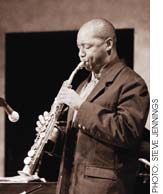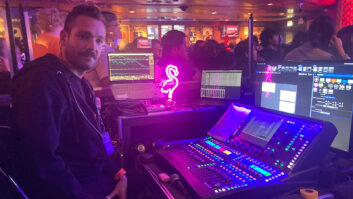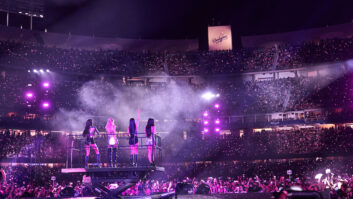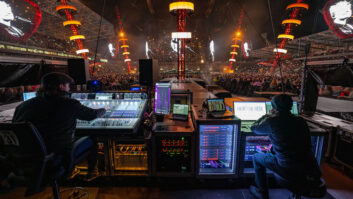
Branford Marsalis, renowned saxophonist and member of one of jazz’smost beloved musical families, never seems to rest. In the lastyear-and-a-half alone, Marsalis founded and launched his ownindependent label (Marsalis Music), issued two solo CDs and a familyeffort entitled The Marsalis Family: A Jazz Celebration andsigned guitarist Doug Wamble for his promising debut, CountryLibations. Touring with world-class musicians such as Marsalis,Jeff “Tain” Watts (drums), Joey Calderazzo (piano) and EricRevis (bass) would demand an equal caliber of perfectionism behind theboard. Grammy Award — winning Rob “Wacko” Hunter,who, incidentally, shares his Best Jazz Instrumental Album (forContemporary Jazz) with this quartet, has been touring withMarsalis since 1996. He amplifies club shows with “as littlesound reinforcement as possible. The balance onstage is reallygood,” he says, “so all I’m doing is pushing it out toreach the people in the back.”

The quartet generally tours symphony halls and intimate clubs, suchas tonight’s venue, Yoshi’s jazz club in Oakland, Calif. Hunter relieson the group’s natural dynamics and uses effects sparingly. Marsalis’vision is to create a natural sound, so Hunter only adds “a tasteof vocal plate on the piano” to open up and color specificverses. Still, he reports that he’s busy behind the board“continuously tweaking. We don’t use any amplification on thebass or any DIs — there are no DIs allowed. Other rules: No saxclips on mics, no Plexiglas, no compression and no gates. Branforddoesn’t use monitors and he’s so in tune with the house that he playsthe mic really well.” In fact, the group is weaning themselvesoff of monitors, so there are only two monitor mixes, one for Revis andthe other for Watts.
Hunter and company travel without P.A. gear, so the Meyer system atYoshi’s (featuring CQ2s and CQ1s, with PSW-2 subs) is a welcome luxury.“We advance the gigs before; sometimes they have what I need andsometimes they don’t. It’s low budget, baby; it’s jazz.” Yoshi’shouse engineer Dan Pettit assisted with this stage setup. Hunter’s micsof choice are Sennheiser 421s and Beyer M88 on the acoustic bass, AKG414s for the piano and a Shure Beta SM58 for a vocal mic, which is usedprimarily as an announce mic. Audience members were pleasantlysurprised by the appearance of guest singer Frank McComb (vocalist forone of Marsalis’ side projects, Buckshot LeFonque), who sang one of theballads slated for the new record. Hunter used the Beta SM58 with justa bit of compression and reverb for McComb.
Hunter may not always have control over what kind of gear list heworks with on the road, but when it comes to miking each of theinstruments and positioning them on the stage, he follows a definiteprogram. According to Hunter, Marsalis prefers that his saxophone bemiked in the soprano position; during shows in larger venues, a smallShure SM98 or Beyer M88 is added to mike the bell. In a small clubsituation, Hunter seems satisfied using a mid-grade mic and mikingMarsalis only when necessary. Because the saxophonist tends to wanderaway from the mic, Hunter notes that it ends up becoming Watts’ micdrum by default.
Hunter mikes the drums in a fairly standard configuration, though hetends not to use tom mics because Watts’ cymbals lie so low. The piano,on the other hand, takes a little more fine-tuning. Hunter likes tomike the piano “up close — but not too close — nearthe hammers of the keyboards, because these guys are so raucous; that’swhy I have the lid down a half-stick. If I have mics too far at the lowend of the soundboard, they just pick up a lot of drum and bass boom. Ihave to get some detail, so I have three mics on the piano. I have onecoming around the back right at the low-end hammers for the low end,and I have a low, mid and high.”
Also part of Hunter’s job is to record live shows as a way for theband to track and archive new material. “We just started thisprocess [of recording] when we got the rig at the start of 2003,”Hunter says. “We record 24 tracks that comprise instrumentation,vocal and lots of audience room mics. Mics go to my own splitter box,then to Millennia Media mic pre’s and from there straight into threeDA98HRs [in HR mode at 48k]. Signal out from the DA98HRs goes to asmall line mixer so I can check from valid signals. I place [the rig]behind the piano onstage, right next to my splitter box, set the levelsat soundcheck and we’re good to go. At the end of the night, I check mytapes and unplug the rig.”
Breean Lingle is Mix’s editorial assistant.






